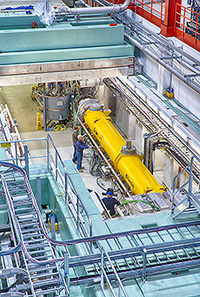Fermilab hosts first ASTA users' meeting
 |
Cryomodule 2 was recently installed in the Advanced Superconducting Test Accelerator in Fermilab's NML building. The first users' meeting for ASTA will take place on July 23 and 24. Photo: Reidar Hahn
|
On July 23 and 24, Fermilab will host the first users' meeting for the Advanced Superconducting Test Accelerator, which produced its first electrons on June 20. The meeting will address the current state of ASTA, plans for the near future and experiment proposals.
ASTA, which will provide a low-energy test beam (50-MeV electrons), an area for several high-energy test beams (300- to 800-MeV electrons), and an electron and proton storage ring called IOTA, is set to be capable of hosting a dozen experiments working in parallel. At the users' meeting, discussion will focus on experiment proposals for accelerator research and development in four main areas: particle physics at the Intensity and Energy frontiers, future superconducting radio-frequency accelerators, novel radiation sources, and stewardship and applications.
So far, 60 individuals have registered, about two-thirds of whom are from outside Fermilab. They represent national labs, industry and academic institutions across the United States, plus CERN in Geneva, Switzerland, and BINP in Novosibirsk, Russia.
"It's a pretty broad and diverse community, and that's exactly the reaction we were hoping for," said Vladimir Shiltsev, ASTA's interim program director and head of Fermilab's Accelerator Physics Center.
The meeting will also feature a seminar with the DOE Office of Science's Eric Colby, who will discuss how ASTA and the new Illinois Accelerator Research Center at Fermilab fit into DOE's global strategy. DOE is increasingly looking for accelerator applications outside high-energy physics, Shiltsev said, and the varied interest in ASTA indicated by the meeting registrants is a positive thing.
"There are many interesting opportunities for accelerator applications, but you need places, you need test beams," he said. "That's where ASTA could be a big splash for the entire community."
Shiltsev hopes that, ultimately, a majority of ASTA users will come from outside Fermilab.
"We want Fermilab to be the world leader in the Intensity Frontier, and ASTA is a big part of that strategy," he said. "I hope Fermilab will be one of the major stakeholders. We want to build more connections with the community. This meeting is a very important first step."
—Laura Dattaro
|